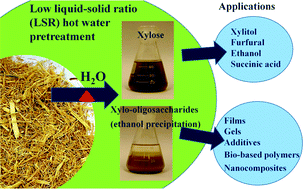Low liquid–solid ratio (LSR) hot water pretreatment of sugarcane bagasse
Abstract
Low liquid–solid ratio (LSR) can be used to obtain high-content xylo-oligosaccharide (XOS) spend liquor by hot

* Corresponding authors
a Programa de Celulosa y Papel, FCEQyN, Universidad Nacional de Misiones, C.P.3300, Posadas, Argentina
b Consejo Nacional de Investigaciones Científicas y Técnicas (CONICET), Capital Federal, Argentina
c
Grupo de Físico-química orgânica, Departamento de Físico-química, Instituto de Química de São Carlos, Universidade de São Paulo, Av. Trabalhador São Carlense 400, Caixa Postal 780, 13560-970 São Carlos, São Paulo, Brazil
E-mail:
aprigio@iqsc.usp.br
Fax: +55 16 3373 9952
Tel: +55 16 3373 9938
d Laboratório Nacional de Ciência e Tecnologia do Bioetanol (CTBE), Centro de Pesquisa em Energia e Materiais (CNPEM), Caixa Postal 6179, 13083-970 Campinas, São Paulo, Brazil
Low liquid–solid ratio (LSR) can be used to obtain high-content xylo-oligosaccharide (XOS) spend liquor by hot

 Please wait while we load your content...
Something went wrong. Try again?
Please wait while we load your content...
Something went wrong. Try again?
M. E. Vallejos, M. D. Zambon, M. C. Area and A. A. da Silva Curvelo, Green Chem., 2012, 14, 1982 DOI: 10.1039/C2GC35397K
To request permission to reproduce material from this article, please go to the Copyright Clearance Center request page.
If you are an author contributing to an RSC publication, you do not need to request permission provided correct acknowledgement is given.
If you are the author of this article, you do not need to request permission to reproduce figures and diagrams provided correct acknowledgement is given. If you want to reproduce the whole article in a third-party publication (excluding your thesis/dissertation for which permission is not required) please go to the Copyright Clearance Center request page.
Read more about how to correctly acknowledge RSC content.
 Fetching data from CrossRef.
Fetching data from CrossRef.
This may take some time to load.
Loading related content
